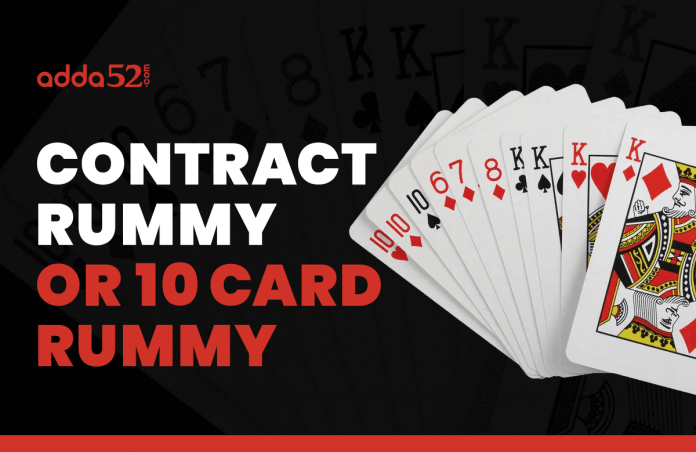Introduction
Also known as 10 Card Rummy, Contract Rummy is a popular card game variation that shares similarities with Gin Rummy. It is played with 3 to 8 players and is believed to have originated in the United States during World War II.
The primary goal is to meld all the cards in hand into sets and sequences. Players aim to fulfil the requirements of each round’s contract by melding, laying off, or discarding cards strategically.
This blog will help you understand the basics of the game and its intricacies, from set-up to tips and tricks. By the end, you’ll understand the intricacies of Contract Rummy.
What is Contract Rummy?
Contract Rummy is all about reaching an agreed-upon score by forming melds, laying off cards, or discarding them.
Contract Rummy is also known by several other names, including Shanghai Rummy, Liverpool Rummy, Joker Rummy, Progressive Rummy, Combination Rummy, King Rummy and Continental Rummy.
Game Setup and Card Ranking
Contract Rummy is played with 3 to 8 players. The number of decks used varies based on the number of players:
- 2 players: 2 decks with 2 jokers.
- 3-4 players: 3 decks with 4 jokers.
- 5-8 players: 4 decks with 8 jokers.
Jokers act as wild cards, allowing players to substitute them for any other card to complete sets or runs.
Hierarchy of card values
In Contract Rummy, cards are ranked in the following order:
- Aces: Aces are the highest-ranking cards in Contract Rummy.
- Kings, Queens, Jacks: Face cards are next in rank, each worth 10 points.
- Numbered Cards: Numbered cards retain their face value.
- Jokers: Jokers serve as wild cards, allowing players to use them to complete sets or runs. However, they also carry a penalty of 15 points each if left in a player’s hand at the end of a round.
Objectives of Contract Rummy and Melds
The primary objective is to meld cards into combinations, to fulfill the contract for each round.
Melding involves organizing cards into sets and sequences, aiming to score points and progress through the rounds. It allows players to minimize their point tally and progress towards completing all seven rounds successfully.
Melding Combinations
- Sets: Sets consist of three or more cards of the same rank, regardless of their suits. For example, a set could be comprised of three Kings (K-K-K) or three Fives (5-5-5) from different suits.
- Sequences: Sequences consist of three or more consecutive cards of the same suit. For instance, a sequence could be 4♠-5♠-6♠ or J♥-Q♥-K♥.
Fulfilling Contracts
Fulfilling the contract for each round is crucial for advancing in the game and accumulating points. Each round has its contract, dictating the combinations required to meld.
By meeting these requirements, players score points and move closer to completing the entire game successfully. The contract specifies the combinations required to meld in that round. For example:
- Round 1: Two sets of three cards each.
- Round 2: One set of three cards and one sequence of four cards.
- Round 3: Two sequences of four cards.
This requires strategic planning and effective card management to meld the required combinations and minimise points left in hand.
Gameplay and Rounds
Contract Rummy consists of seven rounds, each with its own specific objectives and card distribution:
- Round 1: The objective is to form two sets of three cards each. Players are dealt six cards, and the remaining cards form the draw pile.
- Round 2: Players aim to meld one set of three cards and one sequence of four cards. Seven cards are dealt to each player.
- Round 3: The goal is to create two sequences of four cards each. Players receive eight cards each.
- Round 4: Players must meld one set of four cards and one sequence of five cards. They are dealt nine cards each.
- Round 5: The objective is to form two sets of four cards each. Players receive ten cards each.
- Round 6: Players aim to meld one set of five cards and one sequence of six cards. Eleven cards are dealt to each player.
- Round 7: The final round requires players to form one set of six cards and one sequence of seven cards. Twelve cards are dealt to each player.
Player Turn Sequence:
- Drawing: At the beginning of their turn, a player can either draw the top card from the draw pile or take the top card from the discard pile.
- Melding: After drawing, the player can lay down any valid melds (sets or sequences) they have in their hand.
- Laying Off: If the player has valid cards to add to existing melds on the table, they can do so.
- Discarding: Finally, the player must discard one card from their hand onto the discard pile to end their turn.
Scoring System
In Contract Rummy, each card has a specific point value for scoring at the end of the game. Here’s the breakdown:
- Jokers: Each joker is worth 15 points.
- Aces: Aces are valued at 20 points each.
- Face Cards (Kings, Queens, Jacks): Each face card carries 10 points.
- Number Cards (2-10): Number cards are scored based on their face value.
At the end of all rounds, players tally their points based on the cards they’ve collected. The player with the least total points wins the game.
For example, if a player has one ace (20 points), two face cards (20 points), and four number cards (totalling 18 points), along with one joker (15 points), their total score would be 73 points.
This scoring system encourages players to strategize not only in forming melds but also in minimizing the accumulation of high-value cards, such as aces and face cards.
Contract Rummy Tips and Strategies
To excel in Contract Rummy, consider these effective tips and strategies:
Smart Card Management:
- Prioritize melding high-value cards, such as aces and face cards, to minimize point accumulation.
- Keep track of which cards opponents pick and discard to gauge their potential melds and adjust your strategy accordingly.
Melding Strategies:
- Focus on completing sequences and sets early to reduce the risk of getting stuck with high-value cards.
- Aim to create multiple melds in a single turn to increase your chances of going out and ending the round.
Round Prioritization:
- Assess the contract for each round and strategize accordingly. Prioritize fulfilling contracts that require fewer melds to complete.
- Save high-value cards for rounds with contracts that align with your existing melds to minimize point accumulation.
By implementing these strategies, you can improve your decision-making and increase your chances of winning.
Frequently Asked Questions
Can I play Contract Rummy with 8 people?
Yes, Contract Rummy can be played with 8 people. The game accommodates a range of 3 to 8 players, making it versatile for larger gatherings or smaller groups.
How many cards are dealt in Contract Rummy?
In Contract Rummy, the number of cards dealt varies depending on the round. In the first three rounds, each player receives 10 cards, while in the last four rounds, each player is dealt 12 cards.
This gradual increase in the number of cards adds complexity as the game progresses, challenging players to manage their hands effectively and fulfil the requirements of each round’s contract.
Can I use Jokers in a set/sequence of cards in Contract Rummy?
Yes, Jokers can be used in sets or sequences as wild cards to substitute for any missing card. They enable players to complete melds by filling in the gaps and progressing through the game’s phases.
How do I lay off cards on existing melds?
You can add cards to groups or sequences already melded, whether by themselves or opponents.
This involves extending the existing melds on the table with cards from their hand that fit into the established combinations.
What happens if I can’t meet the contract’s requirements for a round in Contract Rummy?
You cannot lay down your melds for that round. As a result, you won’t be able to fulfil the objectives of the round, potentially missing out on points or facing penalties depending on the specific rules of the game.
Can I form a sequence with Aces as both high and low cards in Contract Rummy?
Yes, you can form a sequence with Aces as both high and low cards. This means that a sequence can consist of Ace-2-3 or King-Ace-2. This gives flexibility in arranging cards in sequences.
Conclusion
Throughout this guide, you’ve delved into the nuances of Contract Rummy, from its intriguing history to its intricate rules and strategies. By understanding the objectives, card rankings, and gameplay dynamics, you’re well-equipped to embark on your Contract Rummy journey.
So gather your friends, shuffle the decks, and start playing Contract Rummy now!


